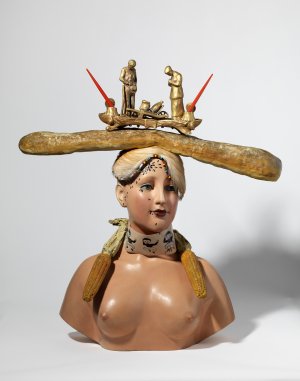Púbol, 23 March 2015
1. Presentation
The Fundació Gala-Salvador Dalí opened the temporary exhibition at Púbol Castle last 23 March. This year it's dedicated to the sculpture of Salvador Dalí and is entitled Retrospective bust of a woman. It will be open to the public from 24 March until 6 January 2016. This is the first time that the Dalí Foundation has organised an exhibition dedicated to sculpture.
2. Concept and content
The exhibition consists of the sculpture entitled Retrospective bust of a woman, a bronze copy from 1976-77 that is usually on display at the Dalí Theatre-Museum in Figueres, as well as 16 photographs by Man Ray, Brassaï, André Caillet, Carl Van Vechten and Eric Schaal, among others, three books, two magazines and an exhibition catalogue. The sculpture is made up of a bronze bust that incorporates different elements applied using the assemblage technique: a baguette, two corncobs, feathers, a zoetrope or strip of painted paper, an inkwell featuring figures from the Angelus with two fountain pens and sand.
The exhibition Retrospective bust of a woman presents one of Salvador Dalí's first sculpture objects, created in 1933. This piece is one of the most important surrealist objects from this period, and it was highly appreciated by the surrealists as demonstrated by the fact that André Breton chose it to illustrate the corresponding chapter in his book What is Surrealism? in 1936. Dalí, once again, in his own provocative way contributed to surrealism with objects that appeal to desire, sex and disruption. Beyond its conceptual importance and iconographic analysis of the surrealist object, the aim in this case is to explore the creative process behind the piece. After an initial introduction to the general concept of a surrealist object and a symbolic object, the exhibition offers a concise description of the characteristics of Dalí's original sculpture. This presentation gives us a better understanding of Dalinian sculpture and, in particular, the way in which some pieces that were originally conceived of as single works were converted decades later, and at the express wish of the artist, into original editions of which a determined number of copies were produced.
Dalí himself defined the surrealist object in The Secret Life in the following words: "disconcerting at first glance, but by virtue of which people were no longer limited to talking about their phobias, manias, feelings and desires, but could now touch then, manipulate and operate them with their own hands".
3. Areas
The exhibition is divided into three areas, one of which includes a display case containing the bust:
a) The object before the object: this section takes us back prior to 1933. By scrutinising photographs we have found some of the elements that would later form part of the assemblage. Dalí tells us that he found the porcelain bust in a hairdresser's. It was probably used as a mannequin to display wigs in the shop window.
b) The life of a single original work: this part of the exhibition provides a chronology of the surrealist object from its creation in 1933 until today and shows how it metamorphosed during that time. For each presentation, Dalí changed its appearance and often its title too; he had not conceived of it as a finished piece and therefore continued to create ephemeral versions of the work. The transformation ends when we rediscover the sculpture in a monographic exhibition on Dalí in 1970 at the Museum Boijmans van Beuningen in Rotterdam and, finally, the MOMA in New York acquired the piece in 1992.
c) The original edition of the surrealist object: here we explain how in the 1970s Dalí created a limited edition (eight copies and four artist's proofs), normally in bronze, of single works from the 1930s. The piece on display today is an example that Dalí personalised in order to put it on permanent display in his Theatre-Museum in Figueres and he designed an entire installation which it formed part of. In a way, he had once again converted it into a unique sculpture. During those years Dalí played with the dichotomy of single works and serial works to demystify the value of the single work.
4. Staging
The staging of the exhibition was designed by Pep Canaleta from 3carme33 and the graphic design is by Alex Gifreu. Inspiration was taken from the staging of exhibitions in the 1920s and 30s dedicated to surrealism and the avant-garde. For the central piece, the bust, the staging reproduces the way in which it was presented for the first time in the Pierre Colle gallery in Paris in 1933.
5. Objectives
To raise awareness of the artist's sculpture work. A large number of pieces are on permanent display at the Dalí Theatre-Museum in Figueres and other examples of Dali's sculpture can be found in diverse objects and installations at the house-museums in Púbol and Portlligat. This display is a necessary part of the work to create a complete catalogue of sculpture. To further this aim, the Dalí Foundation has published some guidelines for defining and classifying original and legitimate sculpture by the artist, which is less well known than his painting but by no means less important.
To document the creative process behind Salvador Dalí's sculpture in general and specifically this work. The photographs that were mainly found in the Dalí Foundation's archives and the research conducted on other sources have together led to a much greater understanding of aspects of Dalí's work that would not otherwise have been possible. We now know that Dalí created sculptures in the 1930s with no other intention than to create surrealist objects and that, many years later, he produced limited series of pieces that were originally conceived of as single works.






